
A computer and network security journalist I often read was in the news last week when his web site was knocked offline by criminals using a "botnet". This was Brian Krebs' web site Krebs on Security (now up and running again).
A botnet ("robot network") is a large collection of compromised computing devices used to overload target computer systems and thus make them inaccessible to everyone i.e. they are unreachable. So many network requests are continually made that the web site cannot cope. These compromised systems could be computers, network routers or, increasingly, so called "internet of things" devices such as security cameras, home monitoring systems, printers, baby monitors and numerous other connected boxes. More and more things are connected which will lead to more and bigger security trouble: even all the way to National Security trouble if people can attack things like the power grid, transport or utilities.
A lot of computers and networking equipment, especially consumer devices, are shipped in a barely secure configuration; many are wide-open to attack. Even for people who know what they are doing, systems can be hard to secure or, in some cases, impossible. Computers are not easy to use and can be baffling and inconsistent. Yes, even Microsoft Windows 10 and Apple Mac OSX; to say nothing of whatever your internet router is running. Most people neither know or care what the "wifi box" runs, and never update it. Often the manufacturer never creates updates anyway, so security bugs sit unfixed. All these things are ripe to be made welcome into someone's botnet No one knows how to fix this mess.

As I read some commentary about the attack on Brian Krebs' web site (a "DDOS", Distributed Denial of Service), I saw a link to another article by Naoki Hiroshima on how he was scammed out of his twitter username. Having a twitter username "@N" made him a constant target for scammers trying to steal it, and eventually they did. They did this by taking over (stealing) his email address. The details are in his post :
How I Lost My $50,000 Twitter Username
One thing that stood out for me after reading his account was his recommendation regarding the use of your own domain for logins e.g. you@yourname.com. This is fine, as long as your domain is secure, because if it isn't and gets stolen, password resets for any of your web site logins are now in the hands of the thief. Using Google GMail or Yahoo Mail email addresses might be better because they are likely to be more secure. Hiroshima's email domain was stolen because the thief swindled his domain management over the telephone; Google or Yahoo would (hopefully) be harder here. They also allow the use of "two factor authentication", using a smartphone based code as well as a password.
So, for standard email messaging, no problem. But account logins? Perhaps worth reconsideration.

I was recently in Edinburgh again, and visited the Traquair center again.
This is to see the great Phoebe Anna Traquair murals of course. I've been here before but I could come back again and again to see them. Beautiful and inspiring. They're only open a few days a year (more during the festival), so it is worth timing your visit. The open day schedule is on their web site.
More on my visit to the city later, I always manage to cram in a lot of culture, and coffee!
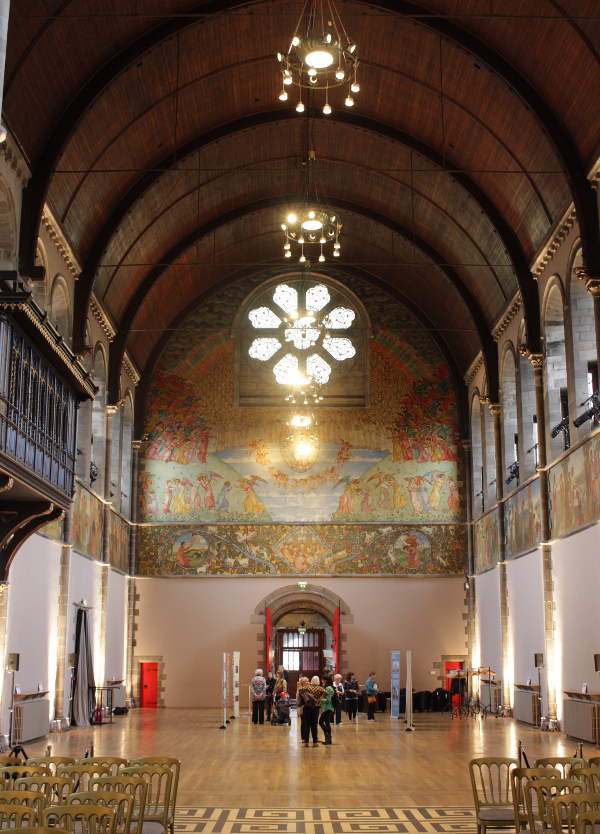
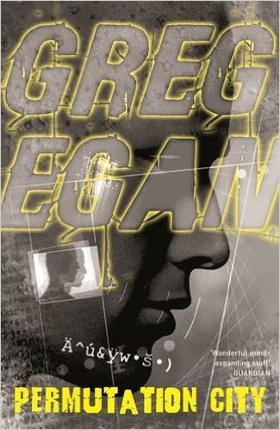
Permutation City
By Greg Egan
Greg Egan writes a form of science-fiction often labelled as "hard", meaning that he's careful to use believable science close to what we think is real or possible, at least potentially. It might also mean that his work is sometimes quite difficult to understand. Having to think a little is a good thing sometimes though.
Permutation City concerns a mid-21st Century future where we can scan ourselves and create a digital "Copy" running on a computer. This is not a new concept of course, but it is explored in new, and sometimes slightly unsettling ways by Egan. Your flesh and blood self might die, and your "Copy" is all that's left of you. Is it "you"? What if your "Copy" decides to clone or copy itself, running another copy, perhaps in a simulated computing system inside a computer.
In this world, after being scanned, you wake up with a marker pen message scrawled on your arm : "you are not the copy". If you wake and look for this message, expecting to find it but don't?
I really enjoyed this novel, even though I had to stop trying to understand the "theory" behind a lot of it (Egan has a FAQ (Frequently Asked Questions) page for some of this stuff). To me, it is a "mind-blowing" type of book: something that makes me think about odd scientific and existential concepts. Philosophy as well. I think this is a worthwhile thing to do.
In 2975, the orphan Yatima is grown from a randomly mutated digital mind seed in the conceptory of Konishi polis.
Not your average novel, but science-fiction does throw up some amazing work sometimes. It's a shame that the "genre" (is this the ghetto?) gets side-lined or looked down on so often. These are very memorable books exploring some deep philosophical concepts.
Ove Arup, engineer, architect and designer, called the way he worked "Total Design". He meant to express the importance of the engineer, as well as the architect and designer in the the task of construction, whether opera houses, penguin pools or bridges. Total Design is the sub-title of Engineering the World at the V&A.

The exhibition takes place in what appears to be a big meccano set, which is perhaps fitting. The framework is actually made up of (so called) gerberettes: a suspended beam and a short propped cantilever. This design was used for the Centre Pompidou in Paris, an Arup engineering building.

Early work included the Penguin Pool at London Zoo (see left). Designed by Berthold Lubetkin and Arup in 1935. Complicated to build, and the V&A shows off some handwritten maths working it all out to prove it.
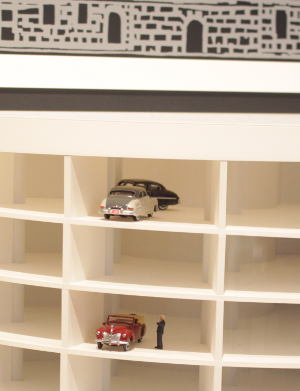
During the war, Arup worked on air-raid shelter design and also a component of a floating harbour used at D-Day. Some of his air-raid shelter designs were to protect a lot of people underground. Post war, he suggested they could be used for car parking.
On the left, the street level is at the top of the image.

This is not the sort of show I'd normally visit but it was very interesting. Ove Arup was a Dane (although born in Newcastle) who moved to the UK in his 20's and spent the rest of his life here. He studied philosophy first in Copenhagen before starting on engineering and as the show states, he formulated his own philosophy, something he called "Total Design": the architect and the engineer should be the closest collaborators from the start.
It is strange to think that the usual way of working in his early days was for the architect to produce designs with no input or thought to the engineering. Consider Jørn Utzon's design of the Sydney Opera House, little more than rough sketches originally. Many thought the design was impossible to build, and indeed changes were needed. But Utzon, Arup and his team managed to do it (against quite a few odds).
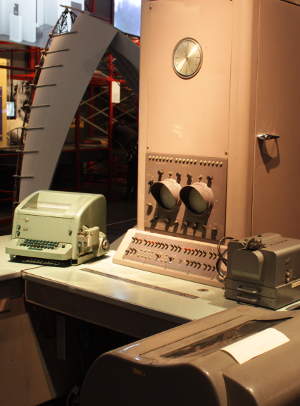
On the right, a Pegasus Mark 1 computer from 1957.
The mathematical calculations used to design the London Zoo Penguin Pool are on show, the long-hand mathematical scrawls hopefully correct, and hopefuly keeping everything in order. Computers started being used in the early sixties and made an immediate impact. Arup was a funny and engaging character and we can listen to a speech he delivered in 1967 as a "christening" of a computer he called "Mumbo Jumbo" (a funny acronym actually). "Mumbo" or "Mum" for short :
When in trouble come to Mum, Mum will do your little sum.
These early computers are large cabinet sized things, greatly superceded now by the smartphone in your pocket. Note the 1960's analog clock on its side.
We can see some of the company's current work on London's Crossrail, as well as a window into its software development, such as crowd simulation or air flow. The Pegasus 1 would have you waiting a long time for results to these sort of equations (to say nothing of the amazing visualisations we now have). We also have a Soundlab room that lets us see and hear work done to simulate and improve the acoustics of buildings: not just theatres but railway station platforms.
Arup the company is still going strong, but the man himself died in 1988.
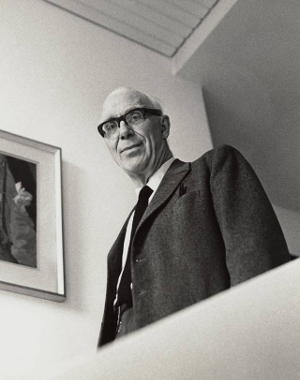
Ove Arup, 1895-1988

A very large, yellow crane on Tottenham Court Road yesterday. I think it was dropping something onto (or into) the building being completed on the right-hand side.
Earlier on, there were a couple of guys walking on the gantry being carried over on the middle-right. I don't think I'd be happy doing a job like that: I don't have much of a head for heights. Beautiful day for it though, and it must have been quite a view. "Crane operations" are quite common in London at the moment.

Sapiens
By Yuval Noah Harari
A popular book, displayed in the bookshop prominently and also heard discussed in its aisles. It has all the usual laudatory blurbs on the cover but I try and train myself to ignore these as much as I can. They're a bit like film trailers: completely unreliable indicators.
Harari's book covers a very long period (millions of years initially, then tens of thousands) as he traces the rise of homo sapiens (the "wise man") over all our brother and sister humans (erectus, neanderthal etc.). We've been very successful but some of that success as come at a great cost to other things, including other animals. Perhaps we're reaching the limits of our ape brain : cue his new book Homo Deus (Guardian article), "A Brief History of Tomorrow".
I enjoyed the book, particularly the way he discusses things like our "cognitive revolution", when our brains grew and we developed tools, technology and better organisation. Also, his description of Sapiens sharing myths that bind and enable such large scale group organisation. These "myths" might include the usual things such as religion, but also the value of money or even the Limited Liability Company. Some of his discussion grates slightly though, such as his use of a phrase like "some religions, such as Christianity and Nazism, have killed millions out of burning hatred". Well, in context, perhaps. But such a needlessly provocative way of expressing this here will alienate people.

Above : Cave of Hands, Argentina. Paintings of human hands from 13,000 to 9,000 years ago.
From wikipedia. CC BY-SA 3.0
The book is best during its first half, as it becomes more a sociological and current affairs discussion in later chapters. Interesting and thought provoking though, just not as deep as some might think.



